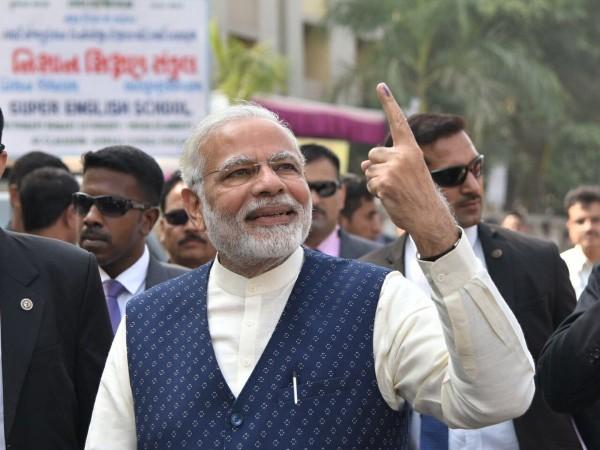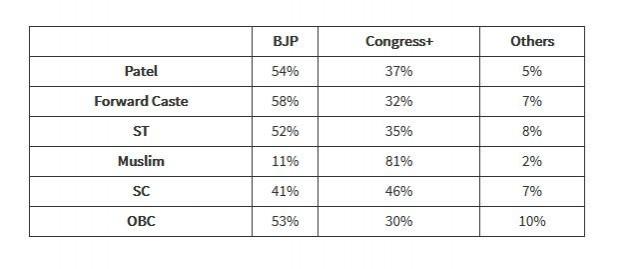
The exit polls released after the conclusion of the second phase of polling in Gujarat on Thursday, December 14, are near-unanimous: The BJP is slated to retain bastion Gujarat, and come to power in the hill state of Himachal Pradesh.
This, despite Congress president-elect Rahul Gandhi running a whirlwind campaign both in Gujarat and on Twitter, and the tumultuous times in HP, where the party has been trying to depose the incumbent Congress government by attacking it over the scams of its leaders for quite some time now.
But is that all that is there to it? Or are some other factors that tilted the balance in the favour of the BJP or away from the Congress? Let us take a look.
Gujarat exit polls
Polling in Gujarat took place in two phases: The first was on December 9 and the second on December 14. However, the Congress may have lost part of its plot when its self-proclaimed "freelance" member Mani Shankar Aiyar called Prime Minister Narendra Modi a "neech kisam ka aadmi."
That alone may have turned the tide in favour of the saffron part, as Modi went on to use that whip to castigate himself raw, earning a lot of sympathy. However, that may be just the tip of the iceberg.
According to an analysis by Today's Chanakya on Gujarat, the biggest issue for the election was development, with 35 percent voters surveyed mentioning it. Second in place, at 34 percent, was the political party — and by extension the candidate — the voter was looking to choose.
A distant third, at 18 percent, was the Goods and Services Tax (GST) regime. The GST — a unified tax regime implemented earlier this year to replace the multiple layers of taxation — was expected to be a big issue in this election. However, it fell behind the two issues Modi and the BJP, the saffron party had raised in Gujarat to get votes..

Another reason could be that the Congress joining hands with Hardik Patel in the hopes that the Patidar Anamat Andolan Samiti (PAAS) and its allied groups would vote for it backfired.
According to the aforementioned survey conducted by Today's Chanakya, 53 percent of the Patels who voted chose the BJP candidate. On the other hand, electors from the scheduled castes (SCs), scheduled tribes (STs) and other backward classes (OBCs) — who stood to lose the most if the Patidars were given reservation in line with their demands — backed the BJP.

The Today's Chanakya survey said that of the total number of votes cast, 52 percent of SC voters, 41 percent of ST voters and 53 percent of OBC voters chose to back the BJP. This was definitely something that the Congress would not have anticipated.
Will the BJP go past the halfway mark of 92 seats in the 192-member Gujarat Assembly? We have to wait for the counting on December 18 for that.
Meanwhile, here is the final tally of the exit polls:
| Polls conducted by: | BJP |
Congress |
| Times Now-VMR | 109 | 70 |
| C-Voter / Republic | 109 | 70 |
| Sahara Samay-CNX | 110-120 | 65-75 |
| India Today–Axis | 99-113 | 68-84 |
| NDTV | 109 | 70 |
| Today's Chanakya | 135 | 47 |
HP exit polls
This is one state racked by political turmoil ever since its incumbent Chief Minister Virbhadra Singh has been accused of, among other things, financial irregularities.
The BJP, on its part, had been trying to topple the Congress government, which had 36 MLAs in the 68-member Assembly by various means — the primary of them being either getting some MLAs disqualified or getting them to switch sides.
Their tactic may have worked in the long term. The people of HP, looking for a stable government, voted for the saffron party. For them, the biggest issue was the political party and the candidate, with 33 percent saying this would decide their choice, according to a Today's Chanakya survey on the election.

The second most important issue was development, something which Modi and the BJP have been using as a poll plank since the 2014 Lok Sabha election. Around 27 percent of voters surveyed by Today's Chanakya cited it as a poll issue this time.
The GST regime was again a third, but not as distant, as 21 percent of voters surveyed said it would decide who they chose. But again, having the third-most important issue in the election does not get votes. This is something that Congress president-elect Rahul Gandhi will have to address when he takes over the reins of the party on December 16.

He will also have to devise a way to bring back voters who have been swayed by the BJP. That will be an uphill task, especially in a state like HP, where all sections of people voted for the saffron party more than the Congress, according to the exit polls.
Here is the final tally of the exit polls of HP:
| Exit polls conducted: | Congress |
BJP |
| Sahara Samay-CNX | 18-24 | 42-52 |
| India Today-Axis | 13-20 | 47-55 |
| TV9-C Voter | 17 | 39 |
| Times Now-VMR | 17 | 51 |
| Today's Chanakya | 13 | 55 |















